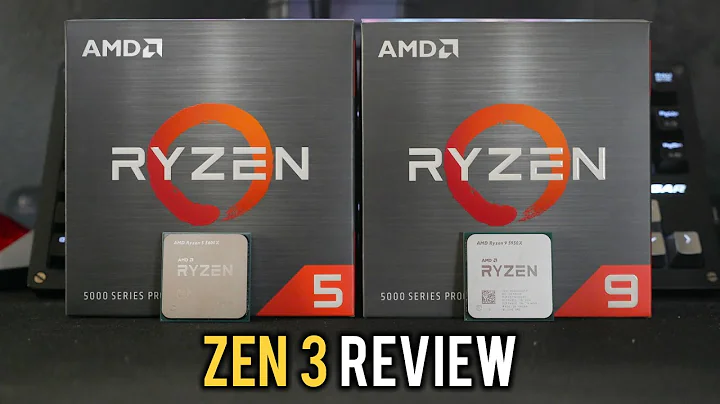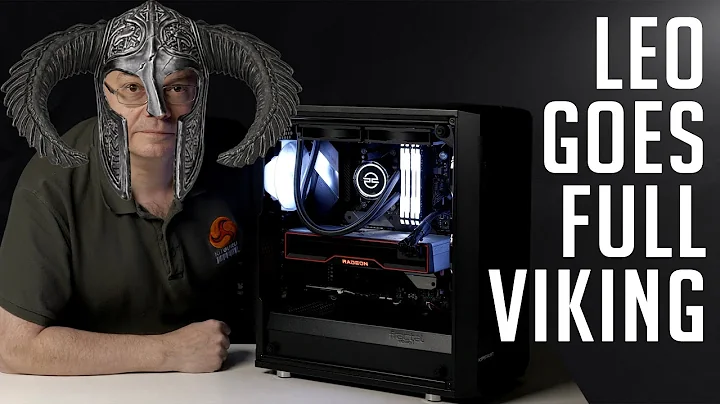Boost Performance: Simple Ryzen 5900X and 5800X Overclock and Undervolt Guide
Table of Contents
- Introduction
- Understanding Overclocking and Undervolting
- Preparing Your System for Overclocking and Undervolting
- Checking Your CPU Temperature Levels
- Adjusting BIOS Settings
- 5.1. Accessing the BIOS
- 5.2. Enabling Precision Boost Overdrive (PBO)
- 5.3. Configuring PBO Limits and Scalar Options
- 5.4. Setting the Max CPU Boost and Platform Thermal Throttle Limit
- 5.5. Utilizing the Curve Optimizer
- testing and Fine-tuning
- Comparing Temperature Results
- Benefits of Overclocking and Undervolting
- Potential Risks and Considerations
- Conclusion
Introduction
Welcome to this guide on how to overclock and undervolt an AMD CPU. In this Tutorial, we will focus on overclocking the AMD Ryzen processors, specifically the 5800X, 5900X, and 5600X. While previous videos have covered more advanced settings, this guide is aimed at providing a simpler method for achieving a performance boost without the need for extensive configuration. By following these steps, you will be able to optimize your CPU's clock speeds and reduce temperatures, resulting in improved overall system performance and stability.
Understanding Overclocking and Undervolting
Before we dive into the technical details, let's briefly discuss what overclocking and undervolting actually mean. Overclocking refers to the process of increasing a component's clock speed above the manufacturer's specified limits. This can lead to improved performance, especially in CPU-intensive tasks such as gaming and content creation. On the other HAND, undervolting involves reducing the amount of voltage supplied to a component, which can help reduce power consumption and heat generation while maintaining stable operation. Both techniques require careful adjustments to achieve the desired results.
Preparing Your System for Overclocking and Undervolting
Before getting started, it's essential to ensure that your system is adequately prepared for the overclocking and undervolting process. Begin by making sure you have a compatible motherboard that supports AMD Precision Boost Overdrive (PBO) and the necessary BIOS version. Additionally, ensure that you have a reliable cooling solution in place. An aftermarket cooler or a high-quality all-in-one liquid cooler will help keep your CPU temperatures in check during the overclocking process.
Checking Your CPU Temperature Levels
To establish a baseline for your CPU's temperature levels, it's important to monitor its performance before making any adjustments. Run a benchmark test, such as Cinebench, and use monitoring software like HWMonitor or NZXT CAM to observe the clock speeds and temperatures. Take note of the average clock speed and the temperature range your CPU operates within during the test. This information will serve as a reference point for comparing the temperature improvements achieved through overclocking and undervolting.
Adjusting BIOS Settings
Now that we have a grasp of the basics, let's move on to adjusting the BIOS settings to achieve the desired overclock and undervolt. Please note that the specific steps may vary depending on the motherboard manufacturer and BIOS version. Refer to your motherboard's manual for detailed instructions. In general, the following steps should guide you through the process:
5.1. Accessing the BIOS
Start by entering the BIOS on your system. This is usually done by pressing a specific key, such as Delete or F2, during the boot sequence. Consult your motherboard's manual or manufacturer's website for the exact key combination.
5.2. Enabling Precision Boost Overdrive (PBO)
Once inside the BIOS, navigate to the advanced settings and locate the option for Precision Boost Overdrive (PBO). Enable this feature to allow for dynamic overclocking and voltage adjustments.
5.3. Configuring PBO Limits and Scalar Options
Within the PBO settings, you will find options for adjusting PBO limits and scalar values. Set the PBO limits to "disable" to prevent any artificial limits imposed by the motherboard. Leave the scalar value on "auto" for automatic adjustment.
5.4. Setting the Max CPU Boost and Platform Thermal Throttle Limit
Next, locate the option for the maximum CPU boost and ensure it is set to "0" or the default value. This setting allows the CPU to boost its clock speed dynamically based on workload demands. Similarly, set the platform thermal throttle limit to "auto" to prevent any unnecessary thermal throttling.
5.5. Utilizing the Curve Optimizer
The curve optimizer is a powerful tool that allows you to fine-tune each core of your CPU individually. Change the optimizer sign to "negative" for all cores and adjust the all-core magnitude value. Recommended values range from 0 to 30, with 30 being the largest undervolt and offering the most significant temperature reduction. Experiment with different values, such as 20, to find the most stable configuration for your CPU.
Testing and Fine-tuning
After applying the BIOS settings, save the changes and exit the BIOS. Allow your system to restart and proceed to test the overclock and undervolt settings. Use tools like Cinebench and run a few gaming Sessions to observe the system's stability and temperature performance. If necessary, make further adjustments to the curve optimizer or other settings until you achieve a balance between performance and temperature that meets your requirements.
Comparing Temperature Results
Once you have fine-tuned your overclock and undervolt settings, it's time to compare the temperature results with the baseline measurements taken earlier. Utilize the same benchmark and monitoring tools to assess the changes in temperature levels. You should observe a noticeable decrease in CPU temperatures, allowing for improved thermal headroom and potentially higher boost clock speeds.
Benefits of Overclocking and Undervolting
Overclocking and undervolting your AMD CPU can yield several benefits. Firstly, you can achieve higher clock speeds, resulting in improved performance in demanding tasks. This can lead to smoother gameplay, faster render times, and increased productivity. Additionally, undervolting helps reduce power consumption and heat generation, contributing to a more energy-efficient and quiet system. Lastly, by optimizing your CPU's performance without compromising stability, you can extend the lifespan of your components.
Potential Risks and Considerations
While overclocking and undervolting can provide significant performance improvements, it's important to be aware of the potential risks and considerations involved. Pushing your CPU beyond its intended limits can lead to instability, system crashes, or even permanent damage. It is crucial to monitor your system's temperatures and stability during stress tests to ensure it operates within safe parameters. Additionally, keep in mind that warranty coverage may be voided if you modify your CPU's settings. Proceed with caution and at your own risk.
Conclusion
In conclusion, overclocking and undervolting your AMD CPU can bring notable performance benefits when done correctly. By following the steps outlined in this guide, you can optimize your system's performance while keeping temperatures in check. Remember to start with conservative settings, monitor your CPU temperatures, and fine-tune your configuration until you achieve a stable and satisfactory balance between performance and temperature. Enjoy the enhanced performance and efficiency that comes with overclocking and undervolting your AMD CPU!
Highlights
- Learn how to overclock and undervolt an AMD CPU for improved performance.
- Understand the difference between overclocking and undervolting and their benefits.
- Prepare your system and Gather the necessary tools for successful overclocking.
- Adjust BIOS settings, enabling Precision Boost Overdrive and tweaking other Relevant options.
- Fine-tune your overclock and undervolt settings based on stability and temperature considerations.
- Compare temperature results before and after overclocking and undervolting.
- Enjoy the benefits of higher clock speeds, improved performance, and reduced power consumption.
- Be aware of the potential risks involved and proceed with caution.
- Maximize your AMD CPU's performance while maintaining stability and reliability.
FAQs
Q: Will overclocking and undervolting void my CPU's warranty?
A: Yes, modifying your CPU's settings may void the warranty. Proceed at your own risk.
Q: What happens if I set overly aggressive overclocking or undervolting settings?
A: Using extreme settings can lead to system instability, crashes, or even permanent damage. Start with conservative settings and monitor your system's performance.
Q: Can I use the same overclocking and undervolting settings for different AMD CPUs?
A: While the general principles remain the same, optimal settings may vary depending on the CPU model and silicon lottery. It's essential to fine-tune your settings for your specific CPU.
Q: How do I revert to default settings if my overclocking or undervolting experiments cause instability?
A: Enter the BIOS and choose the "Load Optimized Defaults" or similar option to reset your settings to the manufacturer's specifications.
Resources:


 59.8K
59.8K
 57.41%
57.41%
 1
1


 < 5K
< 5K
 0
0


 < 5K
< 5K
 2
2


 < 5K
< 5K
 13
13


 < 5K
< 5K
 65.96%
65.96%
 23
23


 13.9K
13.9K
 51.34%
51.34%
 31
31


 14M
14M
 54.77%
54.77%
 17
17


 < 5K
< 5K
 4
4
 WHY YOU SHOULD CHOOSE TOOLIFY
WHY YOU SHOULD CHOOSE TOOLIFY


































